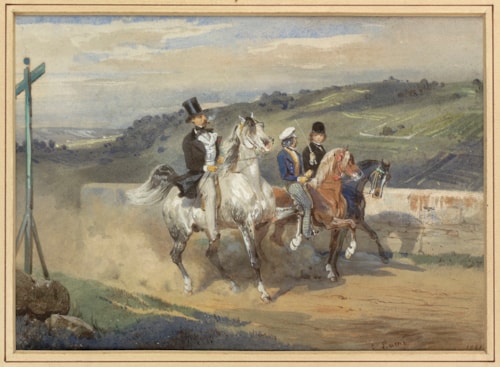
Eugène-Louis LAMI
Paris 1800 - Paris 1890
Biography
After spending some time in the studio of Horace Vernet, Eugène Lami entered the studio of Antoine-Jean Gros at the Ecole des Beaux-Arts in 1817, remaining there for three years. Among his fellow pupils were Paul Delaroche and Richard Parkes Bonington, both of whom were to have an influence on his work. He also became friendly with Théodore Gericault, with whom he shared an abiding interest in equestrian themes. Although he painted military subjects in the early part of his career, as well as numerous studies of military costumes, Lami was to make his reputation as a watercolourist and a master in the depiction of elegant society. He made his debut at the Salon in 1824, with a painting of an episode from a recent French military campaign, and the same year was awarded a medal by Charles X. He spent much of the 1830s at work on thirteen large battle scenes for the Galerie des Batailles at the Château of Versailles. Lami’s appointment in 1832 as court painter to Louis-Philippe at Versailles gave him the opportunity to draw many scenes of formal and informal court life, as well as painting highly finished watercolours depicting the important events of the July Monarchy. He was also appointed as drawing master to the King’s son, the Duc de Nemours.
Lami made his first visit to London in 1826, in the company of Camille Rocqueplan, and returned to England between 1848 and 1852, when he followed Louis-Philippe into exile. While in England he continued to produce watercolour scenes of the fashionable society of London and the court of Queen Victoria, and sent a constant stream of work back to Paris to be exhibited at the Salons. (Lami was himself something of a stylish character, and as Charles Baudelaire noted of him, he was ‘the poet of dandyism, almost English in his love of things aristocratic.’)
Among his other significant patrons were Prince Anatole Demidoff, who described the artist as ‘one of my good friends and one of the most distinguished French painters of our times’, and Baron James de Rothschild, for whom Lami acted as an artistic advisor, planning and supervising the decoration of the Rothschild chateaux at Boulogne and Ferrières. He was a gifted illustrator and lithographer, and in 1879 was one of the founding members of the Société des Aquarellistes Français. Lami continued to work prolifically until his death in 1890, a few weeks shy of his ninety-first birthday. Significant groups of his drawings and watercolours are today in the collections of the Musée Condé in Chantilly, the Victoria and Albert Museum in London, the Louvre and in the Royal Collection at Windsor Castle.



